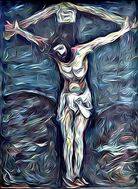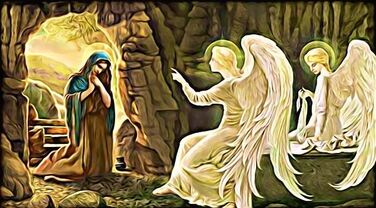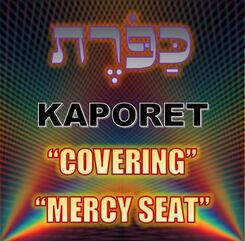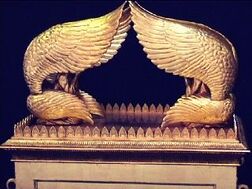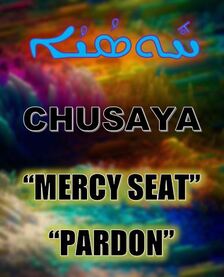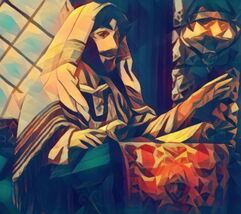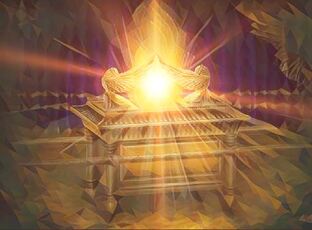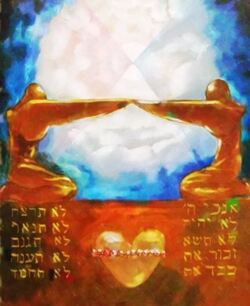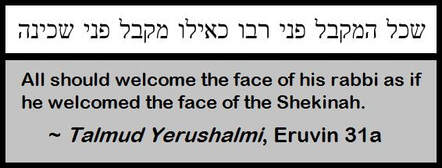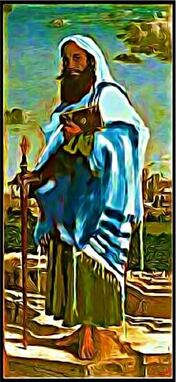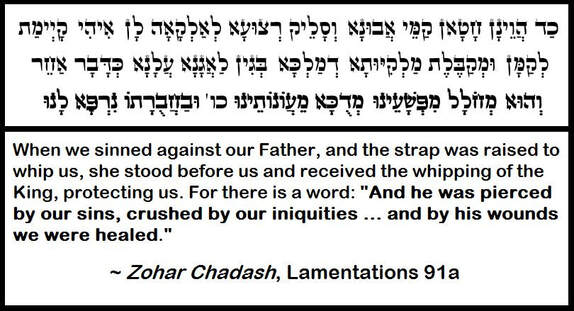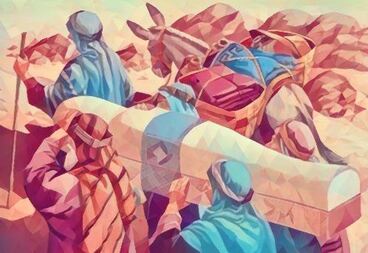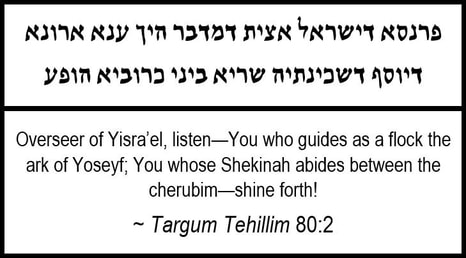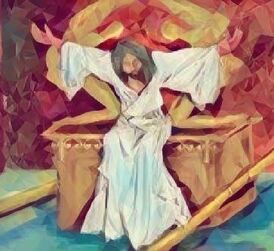BETWEEN CHERUBIM
by Jeremy Chance Springfield
9/13/2021
The Gospels record the different reactions to Yeshua’s startling death on the cross.
All were affected by the scandal surrounding the death of the most polarizing Messianic figure Israel had ever seen.
The book of John records a special detail about the reaction of Yeshua’s followers and the very odd experience that came from their devotion to the fallen teacher.
In chapter 20, Mary Magdalene visits the tomb of Yeshua just days after His demise and finds there the unlikely scenario of an open and vacant tomb. Distraught over the assumption that His corpse had been taken, she cannot bring herself to leave. Instead, she lingers there after the male disciples return home, and in that lonely and unclean place of death, the Holy One blesses her with a grand revelation.
The book of John records a special detail about the reaction of Yeshua’s followers and the very odd experience that came from their devotion to the fallen teacher.
In chapter 20, Mary Magdalene visits the tomb of Yeshua just days after His demise and finds there the unlikely scenario of an open and vacant tomb. Distraught over the assumption that His corpse had been taken, she cannot bring herself to leave. Instead, she lingers there after the male disciples return home, and in that lonely and unclean place of death, the Holy One blesses her with a grand revelation.
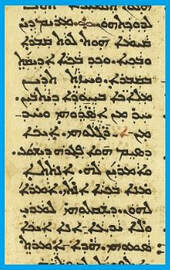
11 Yet, Maryam stood before the tomb, and while weeping, she stared into the tomb,
12 and she saw two angels in white, who were sitting—one at his pillows, and one at his feet—where the body of Yeshua had lain.
13 And they said to her, “Woman, why are you weeping?” She said to them, “They have taken my master, and I do not know where they placed him.”
12 and she saw two angels in white, who were sitting—one at his pillows, and one at his feet—where the body of Yeshua had lain.
13 And they said to her, “Woman, why are you weeping?” She said to them, “They have taken my master, and I do not know where they placed him.”
The details presented here are significant, for they are not included in the other three Gospel accounts of what happened at the empty tomb. It is important to note that the book of John functions on a different level than the three Gospels that come before it. While they are focused on the plain recounting of Yeshua’s ministry to Israel, John tells that same story with a penchant to spiritualize and symbolize the events in a way that highlights the supernatural concepts at work within all that was happening.
It is in this context that we can appreciate what Mary saw as she remained at the tomb. The text of John tells us explicitly two angels were present inside the tomb when Mary looked in that second time. One was at the head of where Yeshua had laid, and one was at the foot of where Yeshua had laid.
It is in this context that we can appreciate what Mary saw as she remained at the tomb. The text of John tells us explicitly two angels were present inside the tomb when Mary looked in that second time. One was at the head of where Yeshua had laid, and one was at the foot of where Yeshua had laid.
This set-up is not arbitrary but signaled a spiritual detail that any Jewish mind would likely seize upon as having a clear parallel in the Torah: the ark of the covenant is viewed as a throne upon which on either side was erected an angel—the cherubim. Exodus 25:18-19 tells us of that detail of the ark’s construction.
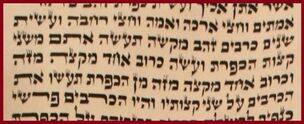
18 And you shall make two keruvim of gold, beaten work shall you make them, at the two ends of the [ark] cover.
19 And make one keruv at one end of it, and one keruv at [the other] end of it; from the [ark] cover you shall make the keruvim over its two ends.
19 And make one keruv at one end of it, and one keruv at [the other] end of it; from the [ark] cover you shall make the keruvim over its two ends.
These two angelic statues are erected atop the cover of the ark. The Hebrew term is KAPORET and has been popularly translated in English versions with the phrase “mercy seat.”
The general idea is merely that of a lid or cover for something. The traditional notion of “mercy seat” stems from the Hebrew term’s alternative usage of “atonement,” and thus by extension, a place of mercy.
The position of the two angels in the empty tomb, sitting at either end of the place where Yeshua’s body had been laid are thus a clear parallel to the angels erected at either end of the covering for the ark of the covenant.
This detail included in John’s text points us to the nature of Yeshua’s death. His death reconciles the sinner to the Most High. Yeshua, as a Tzaddik—a completely righteous one—has the merit to uphold others in His own righteousness. John addresses this concept in his other text: 1st John 2:1-3.
This detail included in John’s text points us to the nature of Yeshua’s death. His death reconciles the sinner to the Most High. Yeshua, as a Tzaddik—a completely righteous one—has the merit to uphold others in His own righteousness. John addresses this concept in his other text: 1st John 2:1-3.
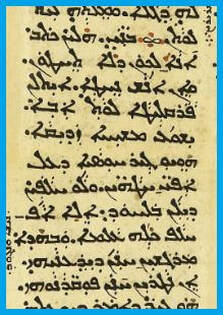
1 My sons, these I write to you, that you do not sin. And if a man shall sin, there is for him an advocate before the Father: Yeshua the Messiah, the Zadika.
2 For he is the mercy seat that is over the face of our sins, and not on behalf of our own only, but also on behalf of the entire world.
3 And by this we perceive that we know him: if we are guarding his commandments.
2 For he is the mercy seat that is over the face of our sins, and not on behalf of our own only, but also on behalf of the entire world.
3 And by this we perceive that we know him: if we are guarding his commandments.
In this passage as translated from the Aramaic of the Peshitta, John blatantly refers to Yeshua as the “mercy seat,” or as the Aramaic term originally says: CHUSAYA. This term could also be rendered as “pardon,” and in that sense also conveys the same general concept at play.
For the sinner who cannot stand with certainty of acceptance before the Presence of the Creator, the righteousness of the Messiah advocates on his behalf as the fulfillment of his duties. Interestingly, John tells us that this happens if we are in communion with Yeshua, and then states that the sinner must be obeying the commandments in some manner for this Messianic merit to be applied on his behalf.
Yeshua will be that covering, that “mercy seat” for the one who is intentionally seeking succor from his sins by attaching to the Tzaddik. This is one way we can understand Yeshua’s words as recorded in Matthew 5:17.
Yeshua will be that covering, that “mercy seat” for the one who is intentionally seeking succor from his sins by attaching to the Tzaddik. This is one way we can understand Yeshua’s words as recorded in Matthew 5:17.

Do not suppose that I came to dismiss the Instruction or the Prophets! I have not come that I should dismiss, but instead, that I should fulfill!
Messiah’s job is to fulfill what is lacking in the obedience of the people. Connecting to Him will offer the sinner a fulfillment they could never experience through their own failures and lack of observance of the Word.
This is essentially what we see in the Torah in the instructions for making the ark of the covenant: in Exodus 25:22 it tells us the Holy One would commune with man between the cherubim on the mercy seat concerning keeping the commandments that are given to Israel.

And I shall meet you there, and I shall speak to you from above the covering, from between the two keruvim which are over [the] ark of the testimony, of all which I will command you [concerning] the sons of Yisra’el.
This parallel is more distinctly appreciated when we understand how the above declaration from the Torah would have been interpreted by first century Judaism. The Most High loves His people and has provided a way to meet with them in the Holy of Holies, between the cherubim, in a moment of mercy.
Repeatedly in the Hebrew Scriptures we encounter the assertion that the Holy One dwells “between the cherubim.” Exactly what that means is not explicitly made clear, but the ancient translators took that information and consistently rendered it in the Aramaic Targums with an intriguing phrase: "the Shekinah who abides between the cherubim." The following example from the Targum to Psalm 99 shows one such instance.
This phrase that specifies that it is the Shekinah that is present between the cherubim of the ark is encountered in almost every instance where mention is made of the Most High’s presence in the Temple. One can see this also in the Targum versions of the following passages: Isaiah 37:16, 2nd Kings 19:15, 1st Chronicles 13:6, 1st Samuel 4:4, 2nd Samuel 6:2, and Song of Songs 3:10.
The Creator is thus understood to be meeting with Israel through the vehicle of His Shekinah—His distinct Presence, often equated with the Holy Spirit—between the cherubim. How does this connect to Yeshua who was laid down in the tomb between two angels of similar positioning? The connection is found in the concept of what a rabbi is supposed to exhibit through his spiritual intimacy with the Creator, as the Talmud mentions in the following quote.
The spiritual teachers of Israel are thus understood to be vehicles of the Shekinah on this earth—ambassadors of His Presence in a world of sin where they fulfill His heavenly will on earth. Yeshua was therefore a vessel for the Shekinah during His earthly ministry.
Another Jewish text connects the Shekinah to the Messiah in a very clear manner.
In this passage we find the Zohar Chadash links the Shekinah (referred to in the feminine as the Hebrew word is feminine) to the suffering Messiah by quoting Isaiah 53:5, showing us that it was the Shekinah who empowered Yeshua to suffer on account of our sins. This is similar to what Paul stated in Romans 3:25.
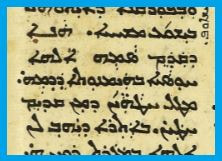
This [one] who Alaha previously set up [for] the mercy seat by trust in his blood on account of our sins that we had previously sinned.
It might seem odd that the Messiah would be linked to the Shekinah in His empty tomb, of all places. How can the Holy One’s Presence be found in such an unclean place? In answer to that are the words of King David in Psalm 139:7-8.
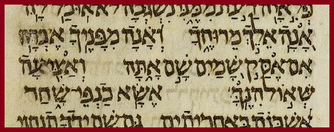
7 Where shall I walk from Your Spirit, and where shall I flee from Your face?
8 If I ascend [to the] heavens, there You are, and [if] I spread a bed [in] the grave, [I will] behold You!
8 If I ascend [to the] heavens, there You are, and [if] I spread a bed [in] the grave, [I will] behold You!
Obviously, there is no place truly devoid of the Presence of the Creator. However, there is a unique precedent for the Shekinah to be connected to a tomb, as the Talmud explains how the ark of the covenant was linked to the sarcophagus of the patriarch Joseph, which was taken from Egypt and traveled through the wilderness with the people of Israel.
The ark carried the earthly Presence of the Holy One amidst His people. It would therefore seem to be in error to allow the uncleanliness of a sarcophagus to be in proximity to the holiness of His Word and His Presence. However, we must appreciate that Joseph’s burial box contained a man who was dedicated to obeying the Creator even in a society of sin and wickedness, and never gave in. His dedication to righteousness earned him a place near the most holy object known to mankind.
The Aramaic Targum to Psalm 80 also clarifies that the reference in the Hebrew text of that verse to the Holy One "leading Joseph" is really a reference to the ark / sarcophagus of the deceased patriarch during its travel in the wilderness, and connects it to the Shekinah who abides between the cherubim atop the ark of the covenant!
In similar fashion, Yeshua proclaimed that he would fulfill the Word, obeying even to the death without giving in. He stood up for the Shekinah and the desire of the Holy One to meet with His people in this world. In light of this reality, we can agree that it makes perfect sense for the two angels to be found in the empty tomb, recreating the imagery of the Holy of Holies and the cherubim on either end of the ark of the covenant.
Those brief but significant details included in the Gospel of John speak to the great desire of the Creator to commune with His people. Returning once more to John’s letter to his fellow believers, we see in 1st John 4:10 that he wished to emphasize the special role Yeshua held in making that holy desire a reality in this world.

In this is love: not that we loved Alaha, but that Alaha Himself loved us, and sent His Son [for] the mercy seat over the face of our sins.
All study contents Copyright Jeremy Chance Springfield, except for graphics and images, which are Copyright their respective creators.
